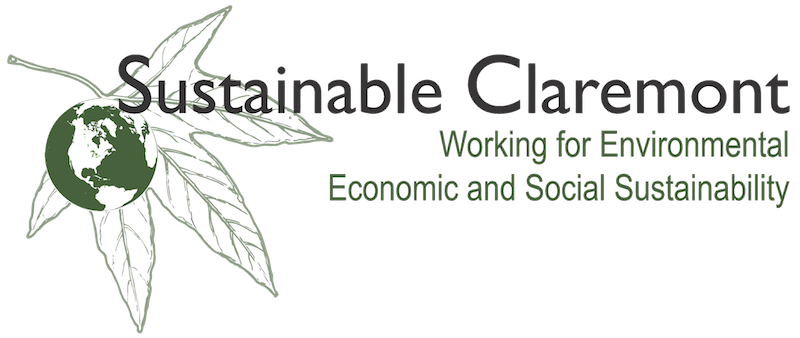Life without a black bin…could you live a week or even a day without throwing anything into the local landfill? Claremont currently diverts 64% of total waste from going to landfill, but has a goal of diverting 70%. Many cities have goals of generating zero waste which actually means that more than 90% avoids the landfill.
Do you find yourself pondering the proper location for a polystyrene foam coffee cup or clamshell? Black bin or blue? How clean does it really need to be? We should begin by thinking about whether the purchasing decisions we make every day produce the ends we have in mind. Consider the 9 Rs:
Refuse. Just don’t buy items that are over-packaged. We might need to shop at different stores, but there are generally alternatives. Purchase loose fruit and vegetables. Think twice before buying small items packaged in large “theft prevention” packages.
Reduce. Just use less. Be sure that the package of food will be eaten before the expiration date. Be sure that we will really use the item that appears to be such a great deal at the moment.
Refill. In Ontario, Canada, 88% of beer bottles are returned and refilled. Only 5% are refilled in the US. Look for products that are available in bulk and use them to refill existing containers at home. Look for soap in pouch packages to refill handy dispenser bottles.
Return. Before purchasing a new electronic item, be sure that the producer will take it back and properly recycle or reuse the components.
Repair. Before purchasing something new, consider repairing the item it was going to replace. If you don’t know how to repair it, find someone who can or donate it to an organization of people who can repair it and sell it.
Repurpose. A lot of things can be used for other purposes. When deciding between two items, consider purchasing the item with additional uses.
Reuse. We throw too many things away too soon. It is sometimes better to pay more for something that will last longer. Think about using an item just one more time before buying its replacement.
Recycle. Be sure that the products purchased are made from or packaged in materials that are easily recycled when ready for disposal. Look for items or packaging made from post-consumer recycled materials. When done with an item and in doubt about where to dispose of it, recycle. Recycling companies are expert at separating the items they can sell from those that must go to landfill. (Does this mean those foam cups and pizza boxes should go in the recycling? )
Rot. More and more cities are adding food scraps to their curbside waste collection for transport to industrial compost sites. Food is a valuable feedstock and the resulting compost is helpful to growers, gardeners and for erosion control. Until Claremont includes food waste collection, think about setting up a home compost system and enrich your garden.
When we purchase with the end in mind, we will automatically reduce the total waste we generate.
The biggest landfill diversion opportunity is with organic waste. Composting can be used to generate soil amendments and fertilizer. Energy from electricity or gas can be produced through anaerobic digestion, gasification or incineration. Over 90% of our total waste could be put to better use or just not purchased in the first place. Producers will continue to produce what we continue to purchase. Buy with the end in mind.
Join us for the next Sustainability Dialog, “Toward Zero Waste”, on Monday, March 7 at 7 pm in the Hahn Building at 420 N. Harvard Ave for a more complete discussion of turning waste into resources.
Demystifying Sustainability is an initiative of Sustainable Claremont (sustainableclaremont.org).
